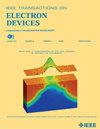Spatially Resolved Conductivity of Rectangular Interconnects Considering Surface Scattering—Part II: Circuit-Compatible Modeling
IF 2.9
2区 工程技术
Q2 ENGINEERING, ELECTRICAL & ELECTRONIC
引用次数: 0
Abstract
In Part I of this work, we had presented a spatially resolved model for conductivity of interconnects capturing surface scattering based on the well-known Fuchs-Sondheimer (FS) approach. However, the proposed spatially resolved FS (SRFS) model involves computing complicated integrals making it ill-suited for circuit simulations. In this part, we build upon our SRFS model to develop a circuit-compatible conductivity model for rectangular interconnects accounting for 2-D surface scattering. The proposed circuit-compatible model offers spatial resolution of conductivity as well as explicit dependence on the physical parameters such as electron mean free path (考虑表面散射的矩形互连器件空间分辨电导率--第二部分:电路兼容建模
在本研究的第一部分,我们基于著名的 Fuchs-Sondheimer (FS) 方法,提出了一种捕捉表面散射的互联导电性空间分辨模型。然而,所提出的空间分辨 FS(SRFS)模型需要计算复杂的积分,因此不适合电路仿真。在本部分中,我们在 SRFS 模型的基础上,为矩形互连开发了一种电路兼容的电导率模型,并考虑了二维表面散射。所提出的电路兼容模型提供了电导率的空间分辨率以及对电子平均自由路径($\lambda _{{0}}$)、镜面反射(p)和互连几何等物理参数的明确依赖性。我们在一定物理参数范围内对电路兼容模型进行了验证,结果表明它与第一部分中提出的物理 SRFS 模型非常匹配(误差小于 0.7%)。我们还将电路兼容模型与之前的空间分辨率分析模型(为进行公平比较而作了适当修改)进行了比较,结果表明我们的模型能更准确地捕捉电导率的空间分辨率以及与物理参数的关系。最后,我们在电路兼容模型的基础上提出了平均电导率的半解析方程。
本文章由计算机程序翻译,如有差异,请以英文原文为准。
求助全文
约1分钟内获得全文
求助全文
来源期刊

IEEE Transactions on Electron Devices
工程技术-工程:电子与电气
CiteScore
5.80
自引率
16.10%
发文量
937
审稿时长
3.8 months
期刊介绍:
IEEE Transactions on Electron Devices publishes original and significant contributions relating to the theory, modeling, design, performance and reliability of electron and ion integrated circuit devices and interconnects, involving insulators, metals, organic materials, micro-plasmas, semiconductors, quantum-effect structures, vacuum devices, and emerging materials with applications in bioelectronics, biomedical electronics, computation, communications, displays, microelectromechanics, imaging, micro-actuators, nanoelectronics, optoelectronics, photovoltaics, power ICs and micro-sensors. Tutorial and review papers on these subjects are also published and occasional special issues appear to present a collection of papers which treat particular areas in more depth and breadth.
 求助内容:
求助内容: 应助结果提醒方式:
应助结果提醒方式:


